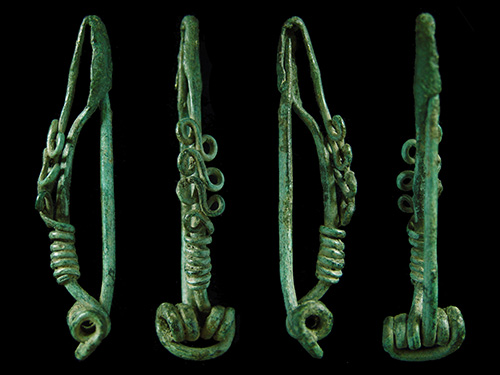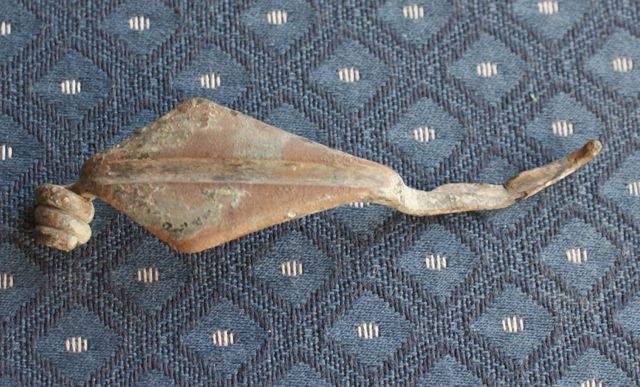Celtic Fibulae|
Fibulae of the Celtic peoples of late Iron Age Europe. These are divided into La Tene phases I, II and III which coincide with early, middle and late La Tene. Though the fibula types were in widespread use across western, central and eastern Europe there were a few regional variations that deserve separate entry, such as the Geto-Dacian group.
La Tène I
Dates: c. 480 - 320/275 BC, alternately 400 - 200 BC.
Notes: The foot is bent upwards to almost touch bow, though there is sometimes a small space between. This part of the foot sometimes ends in an animal head design.

Image: Drawing of a La Tene I, or La Tene A, fibula. The foot is turned up and just touches, but does not connect to, the bow. This example has a bilateral spring with four large diameter winds. This example was found in south Wales. The image is from Houlder, C. and Manning W.H. South Wales, Regional Archaeologies. (1966).
La Tène II
Dates: c. 320/275 - 150 BC, alternately 200 - 100 BC.
Notes: The foot is bent upwards and is attached (tied) to the bow, often by two little wings or extensions which wrap around the bow. The bend at the end of the foot can be rounded or pointed.

Image: The foot on this La Tene II, or Middle La Tene, fibula bends up at the end and is tied, or clipped, to the bow. The waviness of the middle part of the bow is due to damage during burial and was not part of the design. (SC collection)

Image: The foot on this iron La Tene II fibula bends up at the end and is clipped to the bow. This fibula is large - 12.3 cm long (almost 5"). Part of the foot is missing. (SC collection)

Image: The four different view the small La Tene II fibula. This fibula is 43x10x80mm and weighs 2,31g. (Quadrans collection)

Image: The three different view another small La Tene II fibula. This fibula is 26x9x2mm and weighs 1,18g. (Quadrans collection)
Zarubincy
Dates: c. 1st c BC
Notes: Has a narrow triangular bow form and a bilateral spring usually with six winds.
Diamond Bow
Typology: Orlea-Maglavit type La Tene II fibula
Dates: La Tene C2 - D1, c. 2nd century BC, used until mid-1st century BC.
Notes: Has a wide diamond shaped bow, often with a groove, and a bilateral spring, usually with six winds.
Distribution: According to Aurel Rustoiu ("Les fibules daciques a ornements anthropomorphes") this type belongs to the Padea-Panagjurskii Celtic culture and originates in the lower Danube region (southern Romania and northern Bulgaria).

Image: Orlea-maglavit (diamond bow) type of La Tene II fibula. The foot is broken and would have turned up and lain along the bow. (SC collection)
La Tène III
Dates: c. 150 - 30/1 BC
Notes: The form is very similar to the La Tène II fibula, however, the bow is cast.
Nauheim Fibulae|

Type: B1.1
References: Riha 1.1 (pl. 1, 1-8), Ettlinger 1.
Date: c. End 2nd century B.C. - 14 A.D. Nauheim fibulae| are understood as characteristic for the period La Tène D1 (Late Iron Age) and are therefore dated end 2nd - mid 1st century BC. However, Nauheim fibulae| now occur so often at sites of the early Roman Principate that it is no longer convincing to explain all of them as old pieces or dislocated finds. Nauheim fibulae were sporadically still worn by the Celtic population in the second half of the 1st century BC and until the early Roman Principate.
Lauteracher Fibulae

Type: B1.2
References: Riha 1.2
Augst Nauheim Variety Fibula

Type: B1.3
References: Riha 1.3
Comments: Rare.
Early Roman Era
Late Nauheimer Type Fibulae|

References: Riha 2.1 (pl. 4, 1), Ettlinger -.
Date: c. Augustan, c. 30 B.C. - 30 A.D.
Description: Celtic fibula, bow fibula, One-piece construction, tendon (wire connecting two ends of the spring) above the spring, held by spring hook (type B2). Again, the entire fibula from the catch, to the bow, to the hook and plate, to the spring, to the tip of the pin was created by shaping and bending a single piece of bronze with great expertise and skill. The hook holding the spring was an invention of the Augustan period, which did not go beyond the 1st century.
Almgren| fibulae|

References: Riha 1.7, Almgren 65, Bohme 15
Culture: Celtic
Geography: Belgium, Scattered finds Novaesium, Saalburg, and free Germania
Dates: c. 80 - 150 A.D.
Notes: These
fibulae were always worn in pairs as part of the women's costume, as
numerous grave finds from Belgium show. According to the Belgian grave
inventories (inter alia, with coins Domitian and Trajan) the type
belongs to the 2nd century (Böhme 15, note 59). Outside its central
distribution area in Belgium, the type is often found only in Novaesium
and near Saalburg, also isolated finds at several localities in the
Roman provinces and as an exception - in free Germania.

References
Bohme, A. "Die Fibeln der Kastelle Saalburg und Zugmantel" in Saalburg Jahrbuch, XXIX. (1973).
Ettlinger, E. Die römischen Fibeln in der Schweiz. (Bern, 1973).
Mills, N. Celtic and Roman Artefacts. (Derbyshire, 2000).
Popović, P. "Fibule tipa 'Orlea-Maglavit'" in Zbornik Narodnog Muzeja u Beogradu 14-1, archéologie (1992), pp. 319-326.
Riha, E. Die römischen Fibeln aus Augst und Kaiseraugst. (1979). PDF
Celtic Fibulae|
Fibulae of the Celtic peoples of late Iron Age Europe. These are divided into La Tene phases I, II and III which coincide with early, middle and late La Tene. Though the fibula types were in widespread use across western, central and eastern Europe there were a few regional variations that deserve separate entry, such as the Geto-Dacian group.
La Tène I
Dates: c. 480 - 320/275 BC, alternately 400 - 200 BC.
Notes: The foot is bent upwards to almost touch bow, though there is sometimes a small space between. This part of the foot sometimes ends in an animal head design.

Image: Drawing of a La Tene I, or La Tene A, fibula. The foot is turned up and just touches, but does not connect to, the bow. This example has a bilateral spring with four large diameter winds. This example was found in south Wales. The image is from Houlder, C. and Manning W.H. South Wales, Regional Archaeologies. (1966).
La Tène II
Dates: c. 320/275 - 150 BC, alternately 200 - 100 BC.
Notes: The foot is bent upwards and is attached (tied) to the bow, often by two little wings or extensions which wrap around the bow. The bend at the end of the foot can be rounded or pointed.

Image: The foot on this La Tene II, or Middle La Tene, fibula bends up at the end and is tied, or clipped, to the bow. The waviness of the middle part of the bow is due to damage during burial and was not part of the design. (SC collection)

Image: The foot on this iron La Tene II fibula bends up at the end and is clipped to the bow. This fibula is large - 12.3 cm long (almost 5"). Part of the foot is missing. (SC collection)

Image: The four different view the small La Tene II fibula. This fibula is 43x10x80mm and weighs 2,31g. (Quadrans collection)

Image: The three different view another small La Tene II fibula. This fibula is 26x9x2mm and weighs 1,18g. (Quadrans collection)
Zarubincy
Dates: c. 1st c BC
Notes: Has a narrow triangular bow form and a bilateral spring usually with six winds.
Diamond Bow
Typology: Orlea-Maglavit type La Tene II fibula
Dates: La Tene C2 - D1, c. 2nd century BC, used until mid-1st century BC.
Notes: Has a wide diamond shaped bow, often with a groove, and a bilateral spring, usually with six winds.
Distribution: According to Aurel Rustoiu ("Les fibules daciques a ornements anthropomorphes") this type belongs to the Padea-Panagjurskii Celtic culture and originates in the lower Danube region (southern Romania and northern Bulgaria).

Image: Orlea-maglavit (diamond bow) type of La Tene II fibula. The foot is broken and would have turned up and lain along the bow. (SC collection)
La Tène III
Dates: c. 150 - 30/1 BC
Notes: The form is very similar to the La Tène II fibula, however, the bow is cast.
Nauheim Fibulae|

Type: B1.1
References: Riha 1.1 (pl. 1, 1-8), Ettlinger 1.
Date: c. End 2nd century B.C. - 14 A.D. Nauheim fibulae| are understood as characteristic for the period La Tène D1 (Late Iron Age) and are therefore dated end 2nd - mid 1st century BC. However, Nauheim fibulae| now occur so often at sites of the early Roman Principate that it is no longer convincing to explain all of them as old pieces or dislocated finds. Nauheim fibulae were sporadically still worn by the Celtic population in the second half of the 1st century BC and until the early Roman Principate.
Lauteracher Fibulae

Type: B1.2
References: Riha 1.2
Augst Nauheim Variety Fibula

Type: B1.3
References: Riha 1.3
Comments: Rare.
Early Roman Era
Late Nauheimer Type Fibulae|

References: Riha 2.1 (pl. 4, 1), Ettlinger -.
Date: c. Augustan, c. 30 B.C. - 30 A.D.
Description: Celtic fibula, bow fibula, One-piece construction, tendon (wire connecting two ends of the spring) above the spring, held by spring hook (type B2). Again, the entire fibula from the catch, to the bow, to the hook and plate, to the spring, to the tip of the pin was created by shaping and bending a single piece of bronze with great expertise and skill. The hook holding the spring was an invention of the Augustan period, which did not go beyond the 1st century.
Almgren| fibulae|

References: Riha 1.7, Almgren 65, Bohme 15
Culture: Celtic
Geography: Belgium, Scattered finds Novaesium, Saalburg, and free Germania
Dates: c. 80 - 150 A.D.
Notes: These
fibulae were always worn in pairs as part of the women's costume, as
numerous grave finds from Belgium show. According to the Belgian grave
inventories (inter alia, with coins Domitian and Trajan) the type
belongs to the 2nd century (Böhme 15, note 59). Outside its central
distribution area in Belgium, the type is often found only in Novaesium
and near Saalburg, also isolated finds at several localities in the
Roman provinces and as an exception - in free Germania.

References
Bohme, A. "Die Fibeln der Kastelle Saalburg und Zugmantel" in Saalburg Jahrbuch, XXIX. (1973).
Ettlinger, E. Die römischen Fibeln in der Schweiz. (Bern, 1973).
Mills, N. Celtic and Roman Artefacts. (Derbyshire, 2000).
Popović, P. "Fibule tipa 'Orlea-Maglavit'" in Zbornik Narodnog Muzeja u Beogradu 14-1, archéologie (1992), pp. 319-326.
Riha, E. Die römischen Fibeln aus Augst und Kaiseraugst. (1979). PDF
Van Buchem, H. De Fibulae Van Nijmegen. (Nijmegen, 1941). PDF